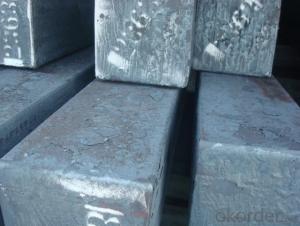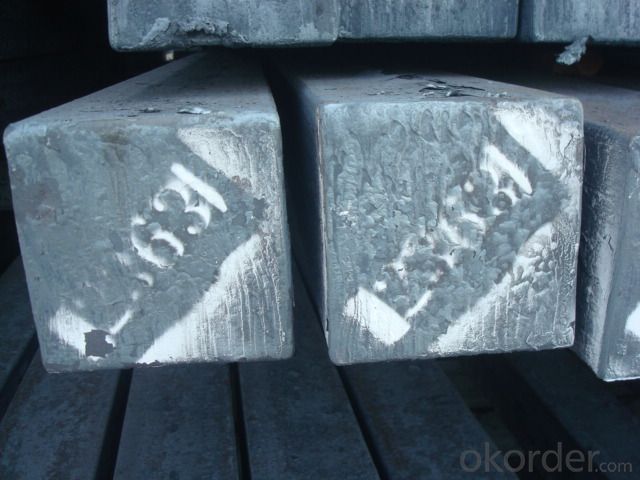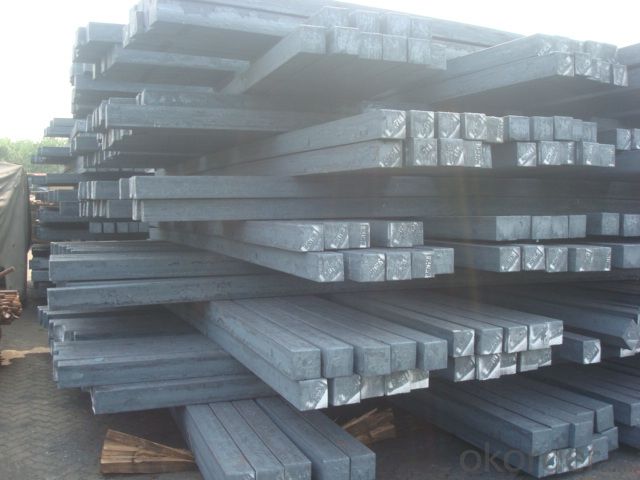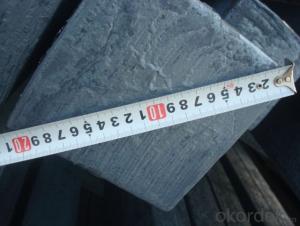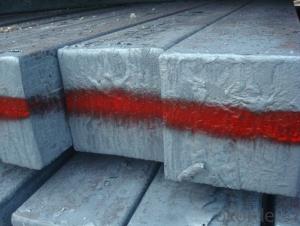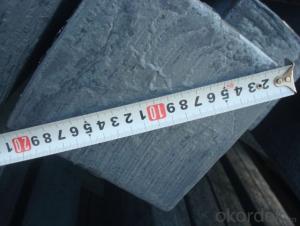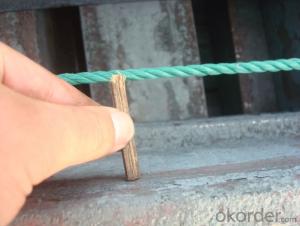Steel Billet Hot Rolled Q235 in Amazing Price
- Loading Port:
- Tianjin
- Payment Terms:
- TT OR LC
- Min Order Qty:
- 1000 m.t.
- Supply Capability:
- 50000 m.t./month
OKorder Service Pledge
OKorder Financial Service
You Might Also Like
1.Structure of Steel Billet
Steel billet(ingot) by cogging or breakdown of semi-finished products, is the raw material of all kinds of steel mill. Billet section of square, round, flat, rectangular and abnormity of several kinds of, mainly related to the shape of rolled products.
2.Main Features of Steel Billet
Rectangular billet continuous casting billet and mainly general carbon steel, low carbon low silicon cold-rolled material, high quality carbon structural steel, high strength low alloy steel, special steel, etc.
The billet is mainly divided into two kinds from the shape:
Slab: cross section width and height of the ratio of the larger, mainly used for rolling plate.
Billet: equal cross section width and height, or a huge difference, mainly used for rolling steel, wire rod. ,
Steel billets have distinct characteristics as compared with already furnished steel bars and products. Billets have a specific grain structure, which enables the metal to be processed more intricately. Steel billets are also known for their malleability and ductility, especially when exposed to varying temperatures during shaping and molding.
3.Steel Billet Images

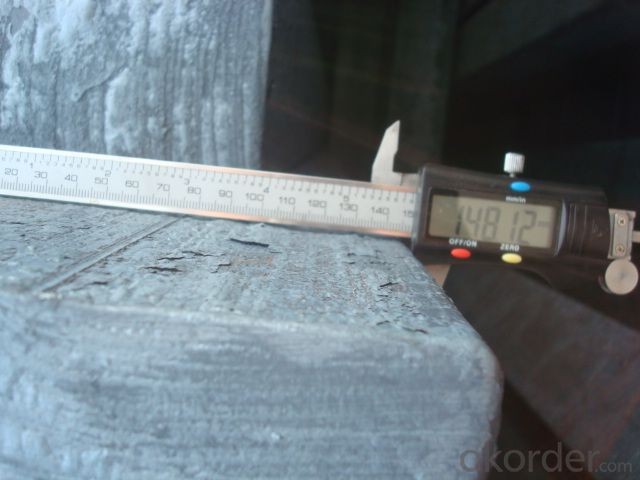
4. Steel Billet Specification
Hot rolled billet steel
Size: 50x50mm-180x180mm
Steel Grade: 3SP, 5SP,Q195,Q235,Q255,Q275 Length:3m-12m
MOQ: 1000MT/size
Payment term: TT or LC
Packing: in bulk , bundle
Shipment: by container , bulk vessel
Packaging Details: bundles with steel strips or as customers's requirements
Delivery time: 15-30 days after the deposit
Loading port:Tianjin, or other port China
Origin :China
Inspection:Third party inspection before loading.
5.FAQ
We have organized several common questions for our clients,may help you sincerely:
1) How about your company?
A world class manufacturer & supplier of castings forging in carbon steel and alloy steel,is one of the large-scale professional investment casting production bases in China,consisting of both casting foundry forging and machining factory. Annually more than 8000 tons Precision casting and forging parts are exported to markets in Europe,America and Japan. OEM casting and forging service available according to customer’s requirements.
2) How to guarantee the quality of the products?
We have established the international advanced quality management system,every link from raw material to final product we have strict quality test;We resolutely put an end to unqualified products flowing into the market. At the same time, we will provide necessary follow-up service assurance.
3) How long can we receive the product after purchase?
In the purchase of product within three working days, We will arrange the factory delivery as soon as possible. The pecific time of receiving is related to the state and position of customers.Commonly 7 to 10 working days can be served.
4)I want to buy products, but I can’t find them in your website.
We have some products not listed on the website. If you can’t see what you are looking for, email us and we will work with you to get you what you want.
How about the guaranty for your products?
A: It depends on the working environment. Generally speaking, the guarantee period for safety shoes is 6 months.
- Q: What are the different quality control measures for steel billets?
- There are several quality control measures that are implemented during the production and inspection of steel billets to ensure their high quality. These measures include: 1. Chemical Composition Analysis: The chemical composition of steel billets is thoroughly analyzed to ensure it meets the required specifications. This analysis involves determining the content of various elements such as carbon, manganese, sulfur, phosphorus, and others. Any deviations from the specified composition can affect the mechanical properties of the billets. 2. Dimensional Inspection: Steel billets undergo dimensional inspection to verify their size, shape, and weight. This involves measuring the length, width, and thickness of the billets using precision instruments and ensuring they meet the specified tolerances. Any deviations from the required dimensions can impact the performance of the billets during subsequent processing. 3. Surface Inspection: The surface of steel billets is inspected for any defects or irregularities. This includes checking for cracks, surface discontinuities, surface roughness, and other imperfections. Surface inspection is typically conducted using visual inspection techniques or non-destructive testing methods such as magnetic particle testing or ultrasonic testing. 4. Mechanical Testing: Mechanical testing is performed to assess the mechanical properties of steel billets. This includes conducting tests such as tensile testing, hardness testing, and impact testing to determine the strength, ductility, toughness, and other mechanical characteristics of the billets. These tests ensure that the billets possess the required mechanical properties for their intended applications. 5. Metallurgical Examination: Metallurgical examination involves studying the microstructure of steel billets through microscopic analysis. This examination helps identify any defects in the metal structure, such as grain size, segregation, inclusions, or improper heat treatment. By assessing the metallurgical properties, the quality control team can ensure that the billets are free from any internal defects that might compromise their structural integrity. 6. Non-Destructive Testing (NDT): Non-destructive testing techniques, such as ultrasonic testing, magnetic particle testing, or eddy current testing, are used to detect internal defects or discontinuities that may not be visible through visual inspection. These methods allow for the detection of flaws without damaging the billets, ensuring their integrity is maintained. 7. Documentation and Traceability: Quality control measures also include maintaining proper documentation and traceability throughout the production process. This includes documenting the results of all inspections, tests, and analyses performed on the steel billets, as well as tracking their origin, processing history, and any relevant certifications. This documentation ensures transparency and enables traceability in case of any quality-related issues. By implementing these quality control measures, steel manufacturers can ensure that the produced billets meet the required specifications, possess the desired properties, and are of high quality, thereby enhancing their reliability and suitability for various applications in industries such as construction, automotive, and manufacturing.
- Q: How are steel billets used in the production of conveyor systems?
- Steel billets are an essential component in the production of conveyor systems as they are used to create the main structural framework. The billets are first heated and then passed through a series of rollers to shape them into the desired form of the conveyor system. This process, known as hot rolling, ensures that the steel billets are transformed into long, slender bars with a consistent cross-sectional shape. Once the steel billets have been shaped, they are further processed to create various components of the conveyor system. These components include conveyor frames, support beams, brackets, and other structural elements that provide stability and strength to the overall system. Steel billets are well-suited for this purpose due to their high tensile strength and durability. In addition to the structural components, steel billets are also used to produce conveyor rollers. These rollers are crucial for facilitating the movement of materials along the conveyor system. The steel billets are machined and formed into cylindrical shapes, which are then fitted with bearings to ensure smooth rotation. The rollers are then installed at regular intervals along the conveyor, allowing for efficient and continuous material handling. Moreover, steel billets are often used to manufacture conveyor belts. The billets are processed into thin sheets, which are then coated with various materials such as rubber or fabric to provide grip and durability. These belts are responsible for carrying the load of the materials being transported and are designed to withstand heavy usage and harsh environments. Overall, steel billets play a vital role in the production of conveyor systems by providing the necessary structural support, as well as components like rollers and belts. Their strength, durability, and versatility make them an ideal choice for constructing conveyor systems that can handle heavy loads and ensure efficient material handling in various industries.
- Q: What are the different types of defects found in steel billets?
- Steel billets can commonly exhibit various types of defects. These defects may arise from the manufacturing process or external factors. A range of defects is often found in steel billets, including the following: 1. Surface defects: These defects are visible on the billet's surface and can comprise scale, scratches, cracks, or pits. Improper handling, inadequate cleaning, or excessive heat during manufacturing can lead to surface defects. 2. Internal defects: These defects are not apparent on the surface and can only be identified through non-destructive testing methods. Voids, inclusions, segregation, or non-uniform microstructures are examples of internal defects. They can impact the steel billet's mechanical properties and overall quality. 3. Decarburization: Exposure to high temperatures or oxygen can cause the surface layer of the billet to lose its carbon content, resulting in decarburization. This defect weakens the billet, reducing its strength and hardness. 4. Shrinkage cavities: When the steel billet solidifies and contracts unevenly, shrinkage cavities form. These cavities can compromise the mechanical properties and structural integrity of the billet. 5. Surface cracks: During the cooling and solidification process, thermal stresses can cause cracks to develop in the billet's surface. These cracks can extend into the interior, leading to additional defects and potential failure. 6. Segregation: Segregation refers to the uneven distribution of elements or impurities within the steel billet. This inconsistency can result in varying mechanical properties, reduced strength, and poor machinability. 7. Inclusions: Inclusions are foreign particles or impurities that become trapped within the steel billet during manufacturing. These inclusions can affect the mechanical properties and cause defects like porosity or brittleness. To ensure high-quality finished products, it is crucial to minimize and control these defects in steel billets. Implementing proper quality control measures, handling materials appropriately, and refining manufacturing processes can help reduce the occurrence of these defects and enhance the overall quality of steel billets.
- Q: What are the different shapes and forms of steel billets?
- Steel billets come in various shapes and forms, including square, rectangular, round, and hexagonal. These shapes and forms are designed to meet specific requirements and applications in various industries, such as construction, manufacturing, and engineering.
- Q: What are the different surface treatment options for steel billets?
- Depending on the specific requirements and applications, steel billets have several options for surface treatment. Some common methods include: 1. Pickling: Steel billets are immersed in an acid solution to eliminate scales and impurities, improving the surface finish and preparing the steel for further treatment or processing. 2. Shot blasting: Small steel shots are propelled at high velocity onto the billet surface, removing rust, scales, and contaminants to achieve a clean and smooth surface finish. 3. Phosphating: A chemical treatment involving the application of a phosphate coating onto the billet surface. This process enhances corrosion resistance, paint adhesion, and provides a uniform surface for subsequent treatments. 4. Galvanizing: A popular option where a layer of zinc is applied to the billet surface through hot-dip or electroplating. This treatment offers excellent corrosion resistance, making it suitable for outdoor use. 5. Coating: Steel billets can be coated with materials like epoxy, polyurethane, or powder coatings to enhance appearance, provide additional corrosion protection, or improve resistance to wear and tear. 6. Passivation: A chemical treatment process that removes free iron or iron oxide from the billet surface and forms a protective oxide layer. This treatment increases corrosion resistance and improves overall performance. When selecting a surface treatment method, it is crucial to consider the specific requirements and intended use of the steel billets. Factors like corrosion resistance, appearance, adhesion, and wear resistance should be taken into account to ensure desired performance and longevity.
- Q: How are steel billets used in the manufacturing of aerospace components?
- Steel billets serve as a crucial raw material in the production of aerospace components. These semi-finished steel products, shaped like squares or rectangular solids, undergo a series of processes to become the required parts. To begin with, the steel billets go through a heating process called "hot working." This involves subjecting the billets to high temperatures, typically around 1200-1300°C, to increase their malleability and facilitate shaping. The heated billets are then passed through rolling mills, where they gradually decrease in size and take on the desired forms, such as bars, rods, or sheets. Once the steel billets have been shaped accordingly, they undergo further processing techniques like forging, extrusion, or machining to create specific aerospace components. For instance, the billets can be forged or machined to manufacture critical parts like engine shafts, landing gear components, or structural supports. The utilization of steel billets in aerospace manufacturing presents several advantages. Steel is renowned for its high strength, durability, and excellent mechanical properties, making it an ideal material for aerospace applications. Steel components can endure extreme conditions, such as high temperatures and pressures, while resisting corrosion and fatigue, thereby ensuring the safety and reliability of aerospace systems. Furthermore, steel billets can be customized to meet the stringent requirements of aerospace components. By carefully controlling the composition, heat treatment, and manufacturing processes, steel billets can be tailored to exhibit specific properties, such as a high strength-to-weight ratio, exceptional heat resistance, or enhanced fatigue life. This customization guarantees that the resulting aerospace components meet the industry's demanding standards. In conclusion, steel billets play a vital role in the production of aerospace components. Through a series of heating, shaping, and processing techniques, steel billets are transformed into various forms that are then further processed to create critical aerospace parts. The utilization of steel as a material offers exceptional strength, durability, and customization possibilities, thereby ensuring the production of high-quality and reliable aerospace components.
- Q: What is the role of steel billets in the production of wire rods?
- Steel billets are a crucial raw material in the production of wire rods. They serve as the starting point for the wire rod manufacturing process. The billets are heated and then passed through a series of rolling mills to reduce their thickness and shape them into wire rods. This process helps to improve the mechanical properties and surface quality of the wire rods. Therefore, steel billets play a significant role in ensuring the quality and strength of wire rods used in various industries such as construction, automotive, and manufacturing.
- Q: Can steel billets be used in the production of energy infrastructure?
- Yes, steel billets can be used in the production of energy infrastructure. Steel is a commonly used material in the construction of power plants, transmission towers, pipelines, and other energy-related structures due to its strength, durability, and resistance to corrosion. Steel billets are the raw form of steel that can be shaped and processed into various components required for energy infrastructure projects.
- Q: What is the role of steel billets in the construction of residential buildings?
- Steel billets are an essential component in the construction of residential buildings as they serve as the raw material for manufacturing various structural steel elements. These billets are heated, shaped, and transformed into different forms such as beams, columns, and reinforcing bars, which provide strength and stability to the building's framework. Additionally, steel billets are also used in the fabrication of other critical components like wall panels and roof trusses, ensuring durability and safety in residential construction.
- Q: What are the different types of steel billet forging machines?
- Today in the market, one can find various steel billet forging machines. These machines are designed to efficiently shape and form steel billets into desired sizes and shapes. Below are some commonly used types: 1. Hydraulic Forging Press: These machines utilize hydraulic power to exert force on the steel billet, allowing it to be forged into the desired shape. Known for their versatility and high force capabilities, hydraulic forging presses can handle different sizes of billets. 2. Mechanical Forging Press: These machines rely on mechanical power, such as flywheels or eccentric mechanisms, to apply force to the billet. They are known for their precision and reliability, making them suitable for high-volume production. 3. Screw Press: Screw presses make use of a rotating screw mechanism to apply force to the steel billet. They operate at high speeds and are energy-efficient. Screw presses are commonly used for forging small to medium-sized billets. 4. Hammer Forging Machine: This type of machine uses a hammering action to shape the steel billet. There are different types of hammer forging machines, including steam hammers, air hammers, and hydraulic hammers. Due to their high impact force, they are ideal for heavy-duty forging. 5. Upsetter: Upsetters, also known as upsetting machines, are specifically designed for forging the ends of steel billets. They use a vertical or horizontal ram to apply pressure, causing the billet to increase in diameter and length. Upsetters are commonly used for producing forged components with thickened ends. 6. Radial Forging Machine: Radial forging machines employ a rotating roller to apply radial force to the steel billet. This force increases the diameter of the billet while maintaining its original length. Radial forging machines are often used for producing seamless rings and other cylindrical components. It is important to consider factors such as billet size and shape, desired production volume, and specific product requirements when selecting the most suitable steel billet forging machine. Each type of machine has its own advantages and limitations, so careful consideration is necessary for the best choice.
Send your message to us
Steel Billet Hot Rolled Q235 in Amazing Price
- Loading Port:
- Tianjin
- Payment Terms:
- TT OR LC
- Min Order Qty:
- 1000 m.t.
- Supply Capability:
- 50000 m.t./month
OKorder Service Pledge
OKorder Financial Service
Similar products
Hot products
Hot Searches
Related keywords
